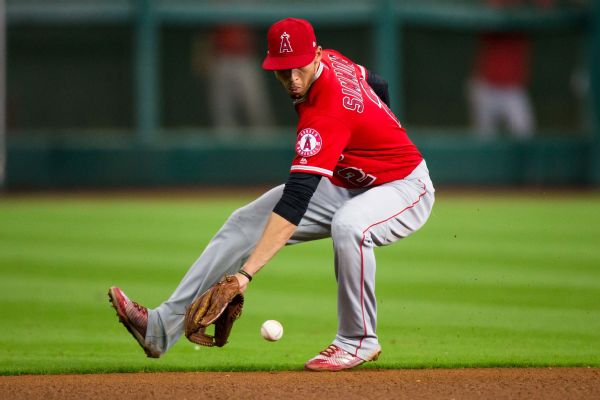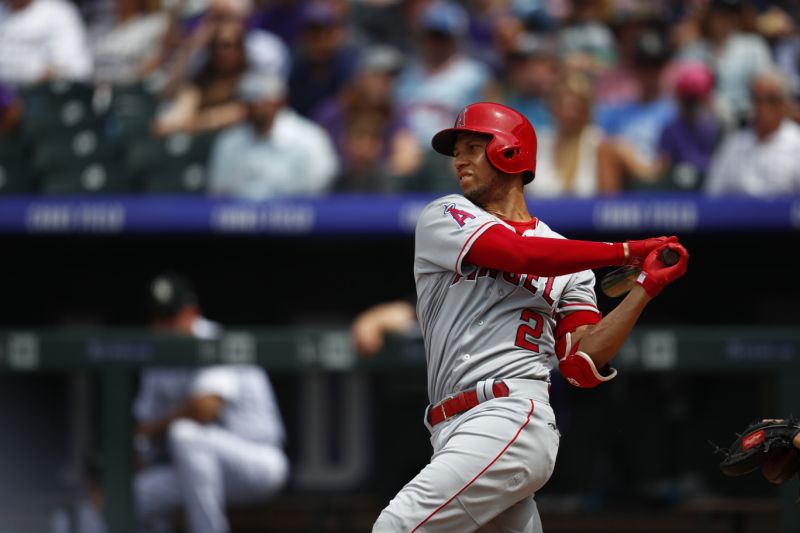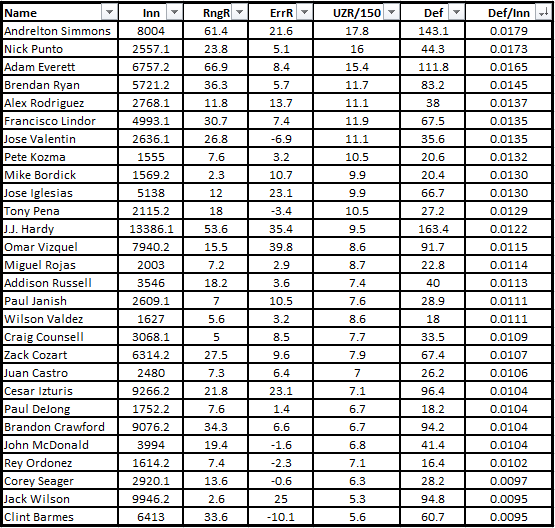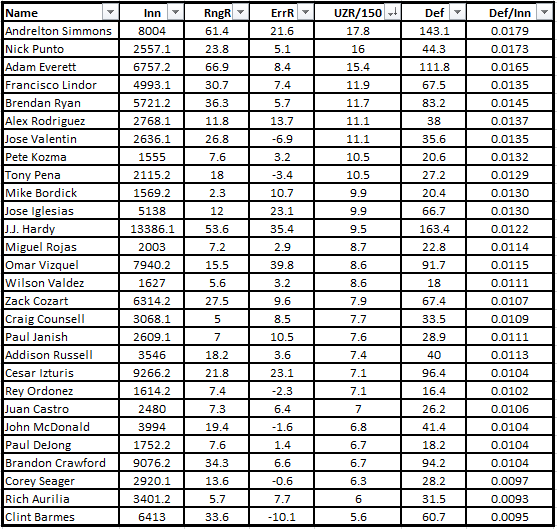By Robert Cunningham, Angelswin.com Senior Writer
Results
2018 was a banner year for Andrelton Simmons, who posted his best WAR season to-date in the Majors, at a sterling 5.5 WAR.
Clearly a lot of that production was on the defensive side of the spectrum but he also turned in a 2nd consecutive above average offensive season too, begging the question of whether or not the Angels should consider extending him.
You may agree or disagree but finding defensive-wizards at critical defensive positions that can post 5-WAR seasons is not an easy task, so it should be on the table in the author’s opinion.
Beyond the actual physical results, Simmons continues to show how brilliant he is tactically on the baseball battlefield. His in-game awareness, ability to back-pick overly aggressive runners, and his range and coverage of the infield is second to none in baseball right now.
Wins Above Replacement (WAR)
So we mentioned above that 2018 was Andrelton’s best season of his career at 5.5 WAR.
It is now the 2nd consecutive season that Simmons has exceeded the 5-WAR mark, as he posted 5.1 WAR last year in 2017.
A significant amount of this WAR improvement has actually come on the offensive side of the ball as Andrelton has worked hard to improve his at-bat’s over the last two seasons.
It is hard to gauge how long Simmons can operate at the 5-WAR level as defense is usually the first player ability that declines with age. Andrelton will be entering his age 29 season in 2019, so age-related decline is something coming into view on the horizon that Eppler and the Angels will need to consider if they really are interested in extending him past his last year of contractual control in 2020.
Offense (wRC+)
The main improvement has come from Andrelton’s increased Hard% (hard hit rate) over the last two seasons. In 2017 he had a Hard% of 29.2% and in 2018 he jumped to 36%. Both of these numbers exceed his career average of 27.4%.
Also over those same two years, he has become more of a pull hitter. In 2017 he had a 45.3% Pull% and in 2018 it jumped to 51%, both higher than his career 42.3% Pull%.
When you combine the harder hit balls to the pull-side along with slight increases in his isolated power (ISO), it has allowed Simmons to place the ball more in the outfield grass. BABIP has been favorable to Andrelton so that could possibly normalize but the changes in ISO and Hard% are probably real advancements that have led to the higher BABIP number so it is not too much of a concern.
In the end he has matured as a hitter and it looks like those changes are here to stay resulting in overall better plate performance that should continue for at least the next couple of seasons, if not longer.
Defense (DEF)
To get a real taste and flavor of how good Andrelton Simmons is on defense, you need to perform a historical comparison of shortstops. Below is a table listing all shortstops from 2002-2018 with a minimum of 1000 innings played sorted by FanGraphs ‘DEF’ metric divided by total innings played to convert it to a rate statistic:
Other than perhaps Nick Punto, no one else really comes close to Simmons consistent defensive rates. Even Ultimate Zone Rating per 150 innings agrees:
In comparison to the nearest active player on the list, Francisco Lindor, who is also considered a fine defensive shortstop, Andrelton exceeds him by 32.5% in Def/Inn and by almost 50% in UZR/150!
The point being made here is that Simmons is a truly gifted defensive player at the most defense-critical position in baseball. Due to the ‘Def’ and ‘UZR’ statistics being imprecise and a lack of quality information for previous generations it is hard to slot Andrelton in on a list of all-time great shortstops (think Mark Belanger, Ozzie Smith, Cal Ripken, Art Fletcher, Ernie Banks, et al) but you have to think he would give any of them a real run for their money.
Eppler has made team defense a very high priority, particularly up-the-middle defense (C, SS, 2B, and CF) and if the Angels want to continue that pursuit of excellence keeping a guy like Simmons on the team would make a lot of sense.
If Andrelton gets injured, the Angels currently have a backup option in Zack Cozart, himself a quality defensive shortstop, and Luis Rengifo down in the high Minors if things get really rough.
Projections
The Steamer projection system sees Andrelton hovering just below his 3-year running average of 4.4 WAR at 4 WAR.
When you consider Simmons age (29 years old for most of the 2019 season) and the fact that defense is the first attribute that a player usually sees decline in, expecting a 4-5 WAR season is probably a reasonable hope for Angels fans. In fact his running 3-year average of 4.4 WAR is probably a good target.
If Andrelton exceeds that number fantastic! If he falls short he is still excelling in all likelihood. Either way the Angels are getting what they paid for and more. This is probably the best value trade to-date for Billy Eppler and may go down as the best overall when all is said and done.
Contractual Details
Simmons is entering his 2nd to last year of contractual control in 2019. Currently, after the 2020 season is complete he will become a free agent.
The current deal was $58M over 7 years that he signed with the Atlanta Braves, originally, prior to the 2014 season at the tender age of 24 years old. The Halos will pay Andrelton $13M in 2019 and $15M in 2020, albeit at a very team-friendly $8.3M average annual value (AAV) across those two seasons.
It is the author’s opinion that the Angels should seriously consider a contract extension for Simmons. This contract value will vary based on your opinion of how defense-first players decline but let me offer up a rudimentary guess at a potential extension contract.
Below is a table using a standard, basic WAR model, a defensive-decline model that discounts more than the standard model, and a historic comparison model:
The first two models use Simmons 3-year running WAR average as a starting base and then add in a 7% year-to-year inflation and also age-related decline (the standard model) and, in the case of the defensive-decline model, additional negative WAR decline year-to-year.
Now let me be clear: the author does not believe in either the standard or defensive-decline models. They are simply there to show you how WAR is still inaccurate as a tool for contract modeling for defense-first players. No one in their right mind would fork out $284M much less $197M for Andrelton in free agency in the author’s personal opinion (and probably the opinion of many, many others).
This brings us to the historical comparison model which is simply taking two recent comparable players, Elvis Andrus and Troy Tulowitzki, and projecting a Simmons extension offer based on those deals.
Here is Elvis Andrus’ last six years of his current contract that aligns well age-wise with Simmons:
That is approximately $90M over six years and it is an easy case that a 7th year would tack on another $10M-$13M, bringing it up, just above, $100M. There is also an easy case to be made that Simmons is a superior player to Elvis but we will leave that alone for now.
Now here is Troy Tulowitzki’s seven years starting at age 29:
That is $114M in total for those years. There is a reasonable case to be made that Tulowitzki, when healthy, was a better overall player than Andrelton but that too we will not touch here.
Inflation plays a factor here (and that is reflected in Andrus’ contract above) but reasonably there is a case to be made that on a 7-year deal, if it was presented to Andrelton this off-season, an extension contract would probably be somewhere in the $100M-$130M range.
Simmons is clearly a superior defender to Andrus and in fact is a better hitter too. Andrelton has also been a much healthier, consistent player than Tulowitzki so there is a case, overall, that Simmons should be on the higher end of not only the salary range but the WAR range as well.
Previously the author had pegged an estimated 6-year, $102M deal, beginning at the end of 2019, as a target. If the Angels were to jump a year early, it would probably be a 7-year, $120M extension contract.
In the end, the Angels need to manage risk and waiting one more year will give them more information about Simmons health and performance. In the era of analytics more data equals greater knowledge and reduces financial exposure and risk. Waiting one more year is worth it from a front office perspective.
Finally one more thing to consider is the available pool of replacement shortstops in the 2020-2021 off-season. In that off-season, it is a truly uninspiring group of names that includes Freddy Galvis and Jurickson Profar.
However, in the following 2021-2022 off-season you see a more interesting group that includes Francisco Lindor, Carlos Correa, Corey Seager, and Trevor Story among others. If the Angels were willing to bridge the 2021 season with a player like Luis Rengifo (himself a potential replacement, perhaps), they could choose to strike at a younger shortstop the year after.
Replacement Options
Part of the reason the Angels acquired Zack Cozart in free agency was to add insurance behind Simmons if he were to get injured and was out for an extended period of time.
To be frank Cozart, despite his strong history of good defense at shortstop, is no Andrelton, in terms of defense. To be even more frank you would be hard pressed to find a better overall player at the position, except for perhaps Francisco Lindor or Manny Machado.
Behind Cozart the Angels have depth in the high Minors with Luis Rengifo and, maybe, someone like David Fletcher. Long-term the Angels will need to consider the value of retaining Andrelton versus letting him enter free agency. That decision, based on the above, is more likely to come next off-season, prior to Simmons last year of control, when Eppler has more information to base his final decision on.
Personally, the author believes Andrelton walks on water and would like to see him locked up sooner rather than later but the Angels could feel differently and may have other areas they want to focus their resources on in the future. It should be noted that Eppler almost certainly wants a strong defensive player at shortstop so that will definitely factor in to the strategic five-year outlook.
Summary
Andrelton Simmons is a terrific player to have on your team.
He plays exceptional defense at the most defensive-critical position in baseball. His offense is above League-average and his wRC+ of 109, in 2018, was significantly above the League-average at shortstop of 95 wRC+. His in-game instincts and leadership on the field are second-to-none in the game right now. No one on this team takes his own personal mistakes more to heart than Simmons does, which drives him to constantly improve his game.
In the end Andrelton is the type of player you want on your team. He is dedicated and committed to his craft and drives himself to perform at the highest level that he can at all times. That makes him a keeper in my book.
Add The Sports Daily to your Google News Feed!






